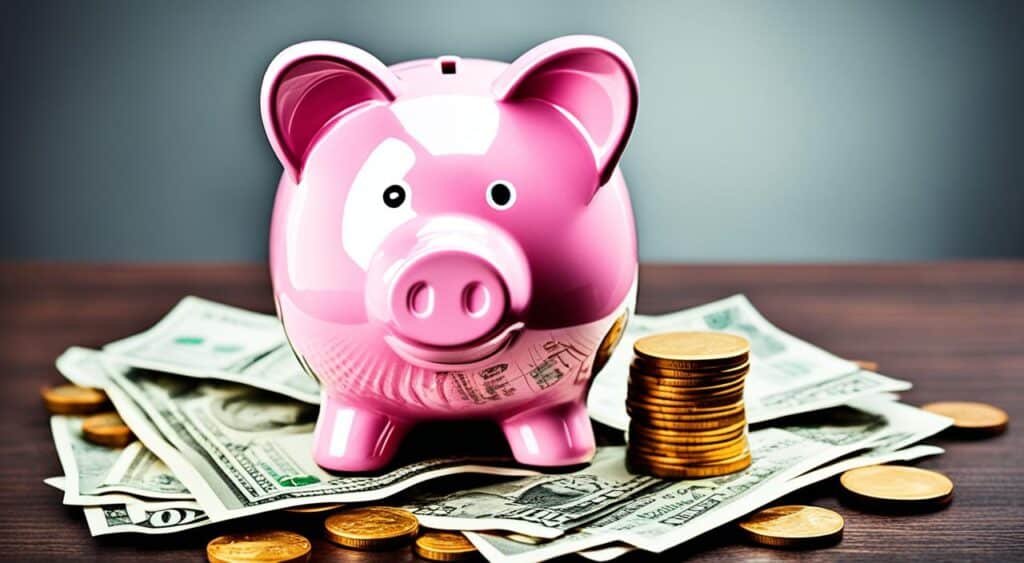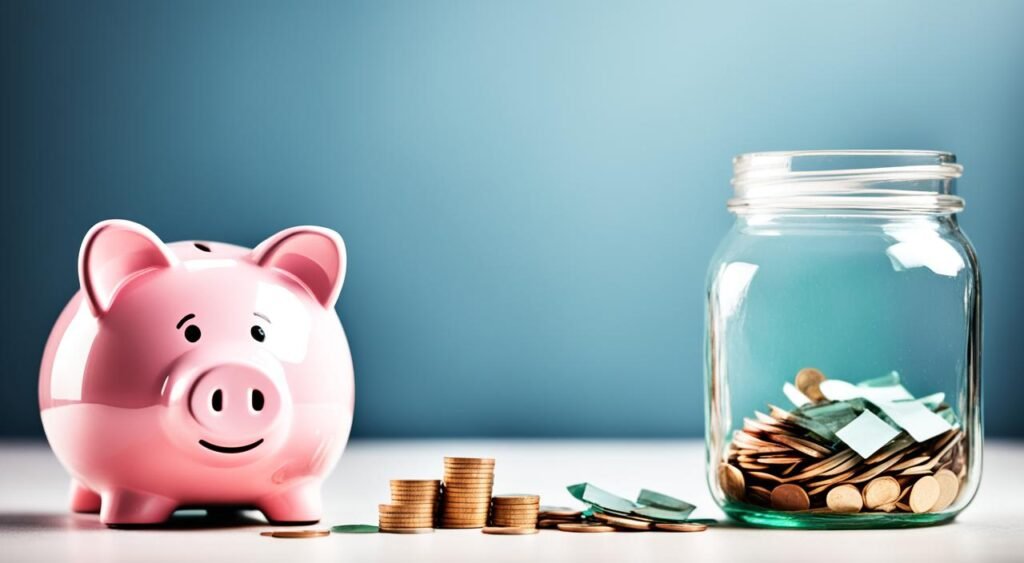In 2022, a Bankrate survey showed only 44% of Americans could handle a $1,000 emergency from savings. People are saving less for surprises due to inflation. Having cash ready for emergencies is key; it stops you from borrowing. Borrowing money to fix a sudden issue can start a financial struggle.
So, this article shares six steps for making and keeping a good emergency fund.
Key Takeaways
- An emergency fund is a savings account set aside for unexpected expenses.
- Building an emergency fund is crucial to financial security and stability.
- Experts recommend saving 3-6 months’ worth of living expenses in an emergency fund.
- Strategies for building an emergency fund include creating a savings habit, managing cash flow, and automating savings.
- Properly utilizing an emergency fund can help avoid taking on debt or dipping into long-term savings.
What is an Emergency Fund?
An emergency fund is money you save for unexpected costs or hard times. It helps with things like fixing your car, your house, or medical needs. If you lose your job, it can also be a big help. Having this fund is important. It can stop a small money problem from becoming a big one. Not having savings means you might turn to debt in tough times. This could hurt your finances for a long time.
Definition and Purpose
The main goal of an emergency fund is to keep you stable and calm when life throws a curveball. It means you don’t have to use credit cards, loans, or expensive debt for sudden costs. A solid emergency fund stops you from worrying too much or facing bad financial effects. It’s like a financial life jacket for you.
“An emergency fund is a cash reserve that’s specifically set aside for unplanned expenses or financial emergencies.”
Having an emergency fund is key for smart money management. It helps you deal with sudden costs without breaking your bank. It’s your safety net in financial storms. Without it, little financial surprises could cause big problems for your wallet.
Why You Need an Emergency Fund
It’s vital to have an emergency fund for financial security. Without it, sudden needs might push you into debt. Then, you might have to pull from your savings, risking your future goals.
An emergency fund safeguards you from these troubles. It ensures your regular and long-term finances won’t shake from unexpected situations.
Moreover, it keeps you away from debt, offering peace and letting you enjoy life without money stress.
To sum up, an emergency fund is a key part of being financially wise. With it, you strengthen your financial security and protect yourself from surprises.
| Benefit | Description |
|---|---|
| Avoid Debt | An emergency fund helps you cover unexpected expenses without relying on credit cards or loans, which can lead to a cycle of debt. |
| Maintain Financial Stability | By having an emergency fund, you can avoid dipping into other savings, such as retirement accounts, to cover unexpected costs, preserving your long-term financial plans. |
| Provide Peace of Mind | An emergency fund can give you the confidence to handle unexpected situations without constantly worrying about your financial well-being. |
“Having an emergency fund is like having a financial parachute – it can save you from a potentially disastrous crash landing when unexpected expenses arise.”
How Much to Save in an Emergency Fund

Many people wonder, how much should I save? Experts suggest saving 3 to 6 months of living costs. This way, you’d have money for unexpected events.
Your target should match your life, like how much you earn and your family size. If your job is stable and you have few family members, aim for 3 months’ savings. But, if you’re not sure about your earnings or have a lot of people to care for, aim for more.
To find your right amount, add up what you spend monthly on basics. Then, use 3 to 6 times this to set your saving goal. This is how most people plan for emergencies.
- Calculate your average monthly living expenses
- Multiply that amount by 3 to 6 to determine your emergency fund savings goal
- Strive to save that amount in a dedicated emergency savings account
“An emergency fund is one of the most important financial safety nets you can have. It provides a crucial buffer against unexpected expenses and helps prevent you from having to go into debt when life throws you a curveball.”
It takes time and commitment to build your emergency savings. But, it’s crucial for staying financially secure. By having a sensible savings plan and sticking to it, you’re prepared for life’s surprises.
Strategies for Building an Emergency Fund

Starting an emergency fund can be tough, but it’s a crucial part of managing money well. You have several ways to set up and grow this fund. These include making saving a habit, seizing one-time chances, and managing your cash flow. These steps make saving easier and more doable.
Create a Savings Habit
Building a saving habit is the first big step. Start with a goal, like saving $500 or $1,000. Make regular small deposits towards this goal. Include this saving in your monthly budget. This way, you slowly but steadily grow your emergency fund.
Manage Your Cash Flow
Looking closely at what you earn and spend is vital. Find ways to cut costs that aren’t necessary. This can include lowering entertainment spending or eating out less. With these cuts, you can save more each month.
Take Advantage of One-Time Opportunities
- Tax refunds
- Bonuses or raises at work
- Inheritance or financial windfalls
Windfalls like tax refunds, work bonuses, or unexpected money are great for saving. Using this extra money for your fund can quickly boost your savings. It’s a good way to add to your fund beyond what you save monthly.
Automate Your Savings
Setting up automatic saves can be a game changer. Use your bank to transfer money directly into your emergency fund. This way, saving is done for you. It takes the hassle out of saving each month.
Save Through Work
- Contribute to an employer-sponsored retirement plan with matching contributions
- Take advantage of any employee savings programs or incentives
- Allocate a portion of your work-related bonuses or pay raises to your emergency fund
Many companies offer benefits that can help you save. These might include retirement plans with employer matches or special savings programs. Using these benefits can help grow your emergency fund without straining your budget.
“Setting up an emergency fund is about more than just saving money. It’s about protecting yourself from life’s surprises, ensuring you’re ready. By using these saving strategies, you can secure your financial future and be prepared for anything.”
Where to Keep Your Emergency Fund

Setting aside money for emergencies is key to a bright financial future. But what’s the best spot for this safety net? You’ve got several choices, each with good points and drawbacks.
Savings Account
A go-to for many is a savings account for emergencies. It’s safe and easy to reach, plus can help your money grow. Say you need cash quickly, it’s simple to take some out.
Prepaid Card
Don’t overlook the prepaid card. It’s a way to keep money secure but separate so you aren’t tempted to spend it. They work well if you’re fighting the urge to buy on a whim.
Cash on Hand
Not everyone trusts banks completely, so keeping some cash hidden can feel safer. It’s good for times when you can’t use a card.
The ideal spot for your emergency fund is one that meets your personal needs. You might use a mix of places to protect your savings. This ensures your money is truly there for emergencies.
| Storage Option | Advantages | Disadvantages |
|---|---|---|
| Savings Account |
|
|
| Prepaid Card |
|
|
| Cash on Hand |
|
|
By weighing up the advantages and disadvantages, you’ll pick the best place for your emergency fund. With the right choice, your money will be safe, easy to get to, and less likely to be spent on non-emergencies.
When to Use Your Emergency Fund
Having an emergency fund is smart, but knowing when to use it is key too. It’s meant for unexpected expenses and big financial emergencies. Some surprises aren’t emergencies though.
It’s vital to have clear rules for true emergencies. This stops you from using it for things you don’t really need. That way, you don’t end up in debt for future unexpected costs.
Here’s when you might use your fund:
- Sudden medical costs, like a surprise doctor’s visit
- Losing your job or a big pay cut
- Fixing your home or car quickly
- Damages from things like natural disasters
But, you shouldn’t dip into it for:
- Buying non-essential stuff, such as a new TV or a trip
- Paying bills you can normally afford each month
- Budgeted things, for example, a planned home update
Setting clear rules on emergency fund use is smart. It keeps it ready for true money crises. And it helps you avoid debt later on.
“An emergency fund is like a financial life raft – it’s there when you need it most, but you don’t want to have to use it for anything other than a true crisis.”
The Psychology of Saving
Saving money isn’t just about numbers. It’s also about how you think. The psychology of saving is pivotal to hitting your savings targets. By using the right mental tricks, you can make saving easy.
Set Smaller Goals
The first challenge when starting to save is the big picture. Saving a lot seems hard. But, if you focus on small, achievable goals, it becomes doable. Cut your big target into smaller checkpoints. This makes saving more fun and easy to track.
Start with Small, Regular Contributions
To build a saving habit, start with small steps. Instead of saving a lot once, try saving a little every week. Even putting away $5 to $10 weekly can grow fast. It also helps you get used to saving regularly.
Once you’re saving regularly, increase your amounts slowly. This speeds up your saving without feeling the pinch.
“The secret of getting ahead is getting started. The secret of getting started is breaking your complex, overwhelming tasks into small, manageable tasks, and then starting on the first one.”
Automating and Streamlining Savings
Setting up automatic savings can help you save consistently. By transferring money from your checking to savings regularly, you won’t miss the cash. This method is simple but very effective. It ensures you keep saving and can meet your financial goals sooner.
Automate Your Savings
Automating your savings is a huge help. It ensures part of your paycheck goes straight to your savings before you can touch it. This approach is known as “pay yourself first.” It’s a smart way to grow your savings without effort.
Avoid Increasing Spending
As you save more, it’s tempting to spend more. But, avoiding this lifestyle inflation is key to saving more. Keeping your spending stable helps you keep saving. Stopping the urge for more can benefit your financial health a lot.
By automating savings and stopping lifestyle inflation, you protect your financial future. These steps will keep your savings growing. They’ll also prepare you for any money surprises down the road.
“Automating your savings is one of the easiest ways to make consistent contributions to your emergency fund.”
Don’t Oversave in an Emergency Fund
Building a strong emergency fund is key, but you need the right amount. It’s vital to save for unexpected costs, but don’t put too much into it. This might slow down your wealth growth in the future.
Experts suggest saving three to six months of living expenses for emergencies. After hitting this target, put extra savings into accounts that earn more. These could be for retirement planning or other investments.
By doing this, the power of compound interest is on your side. It makes your financial future more secure. So, you keep a good emergency fund and let your money work harder for you through smart investments.
An emergency fund is for safety, not for saving forever. It’s important to find the right mix between these savings and smart investing. This mix helps meet your financial goals more quickly and efficiently.
| Savings Allocation | Recommended Amount | Purpose |
|---|---|---|
| Emergency Fund | 3-6 months’ living expenses | Unexpected expenses, job loss, medical emergencies |
| Investments | Excess savings beyond emergency fund | Retirement planning, long-term wealth growth |
Sticking to this balanced plan ensures your money does its best work. Long-term and short-term, your finances are covered. Don’t shy away from investing excess savings beyond the emergency fund savings limit. It unleashes the true power of your earnings.
The Importance of an Emergency Fund

It’s key to have a emergency fund for your financial security. A good fund stops you from using loans or credit cards for sudden costs. This helps avoid getting into debt and keeps your financial stability.
Your emergency fund is like a safety net. It lets you deal with financial surprises without messing up your long-term plans. It protects you from things like losing your job, sudden medical needs, or unexpected home repairs.
Also, an emergency fund gives a lot of peace. You know you can cover must-pay costs in tough times. This lowers your stress and fear, letting you focus on solving the current challenge without worry about bills.
Creating an emergency fund is a smart move for your financial security. It makes sure you’re ready for life’s sudden twists. By valuing the importance of an emergency fund, you’re looking out for your long-term financial health. You’re also protecting your future from unexpected events.
“An emergency fund is the basis of a good financial plan. It’s the first step to being stable and avoiding debt.”
In summary, an emergency fund is vital for your financial health. By saving for it, you shield yourself from surprises and keep your finances safe. So, focus on this important savings goal to secure your financial future.
Also Read: Smart Money Moves: Essential Finance Advice For Success
Conclusion
Building an emergency fund is vital for your financial safety. It helps you avoid debt’s stress by preparing for the unexpected. This article gives tips like saving habit formation and automating savings to build a strong fund.
Starting or improving your financial safety net requires setting goals and sticking to them. This way, you ensure your future is secure and enjoy the peace of being ready for challenges.
Remember, growing your emergency fund takes time. Enjoy the progress and know every penny saved gets you closer to your financial security goal.
FAQs
What is an emergency fund?
An emergency fund is a stash of cash saved for surprise bills or financial trouble. This includes things like fixing your car, house repairs, medical costs, or if you lose your job.
Why do I need an emergency fund?
It’s wise to have saved money to handle unexpected costs. Without it, you might resort to using credit cards or loans. This can start a harmful debt cycle. An emergency fund acts as a security blanket, easing your mind about sudden financial issues.
How much should I save in my emergency fund?
The right amount of savings varies for everyone. Planning to have enough money for 3-6 months of living costs is usually a good idea. If you’re the main breadwinner or have a family, you might need more.
What are some effective strategies for building an emergency fund?
To build your fund, get into the habit of saving. Control how you spend and look for chances to save, like using tax refunds. Employ methods that automatically put money into savings, and check if your job offers a savings option.
Where should I keep my emergency fund?
Choose a secure place for your fund that you can’t easily access for non-emergencies. This might be a special bank account, a prepaid card, or cash in a safe spot at home.
When should I use my emergency fund?
Tap into your emergency money only for true surprises or really tough financial moments. It’s not for daily costs or treats. Stick to the rule of using it when it’s a real emergency.
How do I stay motivated to save for my emergency fund?
Stay excited about saving by setting small and doable aims. Begin with putting away a little money regularly. Also, make saving an automatic process. This builds positive habits and keeps you focused on your emergency fund target.
How much of my overall savings should be in an emergency fund?
It’s key to have a good amount in your fund, but too much might not be the best use of your savings. After reaching your fund target, think about other ways to grow your money, like investing in retirement accounts.





